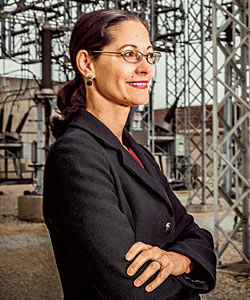Interview by Dirk Johnson

In March, you became the first female CEO of ComEd, which delivers electricity to much of northern Illinois. What does it mean to you to have broken up the boys’ club in the utility industry?
I think it’s a great advantage. It’s a symbol that our business is changing and that something new is happening.
An October ruling by the Illinois Commerce Commission was a blow to your plan to fund a $2.6 billion grid modernization program with higher rates—and it means your revenues will take a projected $500 million hit over the next five years. How does the ruling affect your immediate plans?
We had hoped to start the smart meter program [a rollout of digital meters that provide customers with information about rates according to time and day] next year. Now that won’t happen. We’re appealing the ruling, but we expect to be tied up in court for two years. We were disappointed. Our company has been energized by the possibilities being created by new technologies. But we’ll march ahead.
Why is the smart meter program so important?
It gives people pricing options. It lets them know when it costs more or less to use power at any time. Or if they want to simply tell us their budget, it allows us to call or send them an e-mail twice a month to tell them if they need to make adjustments. We would be able to tell them, “We’re expecting three 90-degree days by the end of the month.”
Can’t we get along with the current system in order to save money?
Our customers have been living in a digital world for at least 15 years. And we’re using a system built for the last century. As a society, we work online, we bank online, shop online, go to school online. Energy is more important to the economy than ever. [But] our industry is in transition.
ComEd is notorious for poor service. It ranked dead last among the Midwest’s 17 largest electric companies in a regional customer satisfaction survey by J.D. Power and Associates. Did you cringe when the report came out?
Even before that, we were hearing loud and clear from our customers when things are not acceptable. We had a very tough summer with storms last year. On July 11, 2011, we experienced the biggest storm we’ve had in the recorded history at ComEd. But we do not for a minute suggest we don’t have a lot of room for improvement.
What are you doing about it?
We’ve put together a storm task force. We’ve made 60 specific changes. We’ve added 20 percent to the ranks of our first responders. We’ve changed the way we do damage assessment, so crews have a better idea what they will be facing. We’ve expanded the number of wire watchers [employees who monitor downed wires]. We’ve put a GPS on all of our crews and established a Smart Board that shows their locations and a visual of all outages, which improves coordination. We used to literally sort through a stack of tickets. It was not efficient.
Has response time improved?
Historically, after a severe storm, it took us four and a half days to reach power restoration for all users. In 2012, we’ve cut that time by a full day.
How about the time people spend on the phone in aggravation waiting to get through to ComEd?
It’s bad enough to be without power, so people at least want to be able to reach us to find out what’s being done about it. So we’ve doubled our telephone trunk to 2,000 lines. We’ve expanded the ways people can reach us. Now they can connect to us through text, Twitter, Facebook. On our website [comed.com], we now have a map that shows the outages, the causes, the crew status, and when power will be back. We’ve created the capability for a joint operating center, where we set up a station in a hard-hit area where people can come and share information with us. We set one up in DuPage County this summer. It’s a real breakthrough.
So we should see a steep drop-off in the frustration level with ComEd?
I don’t want to claim victory. We have a lot of work to do. But we’re on a good path.
With the emergence of alternative energy suppliers, what’s your market share now?
It’s 50 percent with residential customers. Depending on referenda in Chicago and other towns, it could be down to 25 percent by the end of the year.
Doesn’t a smaller share mean less revenue?
We operate the infrastructure: the poles and the wires. We’re a pass-through. We have no incentive to keep power customers with us.
What do you do when you’re not working?
I’m a soccer mom. I have a 16-year-old. He’s a pretty good soccer player and a very good kid.
So you allow yourself some time to get away?
I try to take off one day a week. But in this job, realistically, wherever you are, you’re paying attention to something about the job all of the time.
* * *
Power Punch
ComEd by the numbers
3.8 million
Number of ComEd customers
8,300 miles
Amount of underground cable maintained by the utility
366 minutes
ComEd’s average response time after storms in 2011, a year with particularly severe weather (excluding storms, the average response time was 89 minutes)
45,624
Number of service interruptions in 2011 that affected 10 or more customers
579
ComEd’s abysmal rating (on a 1,000-point scale) in a 2012 J.D. Power and Associates consumer satisfaction survey
2,143
Number of those outages caused by squirrels
28
Number of registered ComEd lobbyists (individuals and firms) in Springfield
$1,029
Cost of a 6,500-watt portable generator at Abt Electronics in Glenview
Photograph: Bob Stefko


